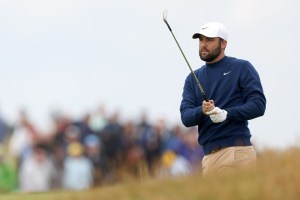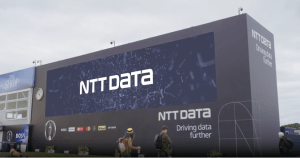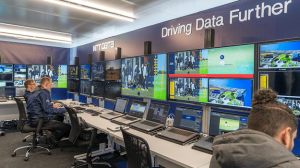Whether it was Rory McIlroy somehow digging up an old ball while taking a shot, or watching Scottie Scheffler secure his first Claret Jug, the 2025 Golf Open Championship was a tournament full of memorable moments for golf fans.
But for those attending the professional golf’s oldest major at Royal Portrush in Northern Ireland last week, many of the moments – and the stats behind them – were captured on a 20-meter-wide digital board.
The NTT Data Wall isn’t a new thing at the Open. In fact, NTT’s partnership with the Open, spans more than a decade. Over the years, the partnership has seen the re-invention of the fan experience at the championship and has supported The R&A, the organisers of The Open, with its digital plans.
 Golfer Scottie Scheffler at the 2025 Open, which he went on to win
Golfer Scottie Scheffler at the 2025 Open, which he went on to win
Since its inception in 2014, the NTT Data Wall has become a fan-favourite destination at The Open, offering spectators immersive, data-driven insights into the action on the course on a 20-metre-wide digital board.
Fresh from the event, Professor Steve Otto, CTO at The R&A, talked with TechInformed about the fan experience and recent tech innovations.
“We have had a long-term partnership with NTT Data,” he says. “That has been an evolution of what we can do together, but the key change that has enabled us to improve the fan experience has been data accuracy.
“For us, reputation is everything. We’ve almost held off making certain innovations in the past until we could confirm how accurate the data was. But in recent years we’ve reached the point where we could really validate our data and start to look at enhancing the Data Wall.”
Wonder wall
Initially just a large screen, the Wall has transformed to a sophisticated hub of real-time sports analytics and viewer interaction.
Composed of 400 LED panels, the NTT Data Wall, which requires three weeks of meticulous construction and setup, boasts of 2.8 million pixels. The core of its operation is driven by Unreal Engine 5, allowing for real-time, near-photorealistic animations powered by high-end GPUs housed onsite, ensuring minimal latency and maximum processing power.
But in recent year, NTT has really upped its game, leveraging advancements in data processing to offer fans more detailed insights than ever before.
 NTT Data Wall provides insights to attendees of The Open
NTT Data Wall provides insights to attendees of The Open
Data from ShotView, which captures every shot by every player, is received in less than a second, with each of the 32,000 shots taken during the championship analysed. This amounts to millions of data points processed, which is then mapped to player statistics and visuals on the screen within 100 milliseconds, synchronising seamlessly with live broadcast feeds.
Every one of The Open courses has been mapped using drones and Lidar scanning to capture every bump, bunker and slope to 2cm accuracy. During the championship, computer vision cameras set up at every hole track golf balls across the green, while 60 people around the course use GPS trackers to record the location on the fairway where every ball comes to rest.
This year was the first event in which the Data Wall featured highly produced pre-recorded video and animation content. The R&A was also able to customise the content on the wall as play progresses, which was not previously feasible.
NTT Data said upgraded technology capabilities onsite also enabled organisers to change the weather on the ShotView platform to mirror the weather on the day, as well as interrogate individual holes with “hot-spots” that showed challenges players faced on the hole, and trigger custom news items on specific players at key moments of play.
The key purpose of pushing enhancements in real-time immersive content and fan interaction, adds Otto, was not just about offering insights. “It is also about entertainment,” he explains.
“We look at the dwell time in front of the screens and even put bean bags on the grass near the Wall to give that sort of village feeling.”
Putting legacy with innovation
One of the most iconic sights at The Open is the yellow scoreboard perched above the 18th green—still updated entirely by hand.
Despite the wider digital transformation across the event, that scoreboard remains manual by design. “That is what people expect,” says Otto. “When we ask fans about replacing it, they say they prefer it—it’s a sacred part of the experience.”
To balance tradition with innovation, the R&A has introduced digital scoreboards throughout the course while preserving the classic elements where they matter most. Otto says the organisation works closely with its tech partners—particularly NTT Data—to decide where and how to evolve. Many of those choices, he adds, are “based on the art of the possible.”
For example, the availability of better GPS tracking of balls has allowed the Wall to offer much deeper insights into how a shot has been played. This has made generation of graphics – such as those that show the arc of a shot – much quicker, but also more accurate.
“We care about making it real, rather than shiny, so every innovation is tested to see what it offers our fans,” he says.
One key innovation this year was how data insights were delivered—not just on the NTT Data Wall, but also through The Open’s official app and website.
“Users can now replay an entire hole to see how a player navigated it,” explains Otto. “With improved tracking data, we can also compare how players approached the same holes during previous tournaments—like the last time The Open was held at Portrush in 2019. That historical depth is invaluable.”
These insights aren’t just useful for fans. Organisers can now assess the real-world impact of course changes over time. For example, if a bunker is relocated, data can show how that adjustment influences player strategy.
“Now we can look at how holes played before and after a change,” Otto says. “You get a clear, data-driven view of how course modifications actually affect the game.”
Getting on course
While viral moments – such as when Rory McIlroy unearthed an old, buried ball while taking a shot on the 11th hole – capture the public’s attention on social media, it is often successful shots which golf fanatics will revisit.
“Some moments are great when they go viral, but the data only really cares about the ball that is hit, and people who play golf mostly look at the data of shots that have been hit well,” Otto tells TI.
 The data operation behind the scenes
The data operation behind the scenes
He adds: “What has changed for us is the speed which we can deliver this data to people’s phones. When we first started offering more insights, they were almost scripted content – prompting users to watch shots from earlier in the day.
“But now we can show people shots from other holes almost live, through the scorecard, meaning our users can curate their experience a lot more.”
Delivering this volume of data is “not trivial” he adds and requires significant data optimisation and flow management in the backend. One challenge, however, is that The Open is held at a different venue each year.
But the organisation is so keen to ensure a quality, consistent tech environment that it has installed fibre-optic cabling and ducting one metre below ground around every one of the nine independent golf courses that currently make up the Open roster.
This has been repeatedly upgraded, from 1GBPS a few years ago, to 10G, and up to 100G in the future, Otto predicts.
Other large scale sporting events have used mobile connectivity to support broadcasters and attendees. At the 2024 Olympics, for example, Orange provided a private 5G network across Paris.
Otto also has his eyes on 5G and the capabilities of private networks. In 2024, NTT Data trialled the use of a private 5G “network in a box” at Troon, focused around the hospitality area.
“The data requirements are going up and up every year,” he explains. “We’ve always used fibre to support our broadcast partners and attendees, but next year we expect to trial our own broadcast network over 5G.
“We will run a private network as a case study to see how it performs, and whether it can replace the fibre.”
The Open isn’t the R&A’s only event – this coming week, it will host 2025 AIG Women’s Open at Royal Porthcawl Golf Club in Porthcawl, Wales.
The body is also the organiser for the Senior Open Championship – occurring this week at Sunningdale in Berkshire – and the Walker Cup and Curtis Cup.
Running multiple events – including three majors – means it is important for Otto, as tech leader, to find “scalable solutions”.
“We want to use the same solutions for broadcast and for attendees, and we can often learn lessons from the smaller of those events that can be scaled for the majors,” he explains.
Otto is also keeping a close eye on how AI evolves, believing it could play a significant role in The R&A’s future operations.
“We have trialled some smaller AI use cases this year, including in our merchandise shop, to look at tracking people, but that was more just testing the waters to see what benefits we might gain from it.
“Our focus is how does AI enhance our insights and understanding of how people behave on site, and how that can be fed back to the business.”
But he adds a word of caution: “I am very conscious of people’s data and maintaining security,” he adds. “We need to make sure AI is solving a problem that regular analysis can’t solve, rather than just introducing AI for the sake of it.
“That is a big mantra for the R&A across both our normal operations and for the Open.”
Data governance, he adds, is vital to the Open’s successes with its fan engagement. That, at times, has led Otto to hit the pause button to make sure they are taking the right approach, whether it be data security or structures.
“If it is garbage in, it will be garbage out,” he adds. “The key advice I’d offer CTO’s looking to gain more insights or improve customer experiences is make sure the problems you are solving are real, rather than ones being suggest by tech suppliers; and get your house in order before you launch any project.”







